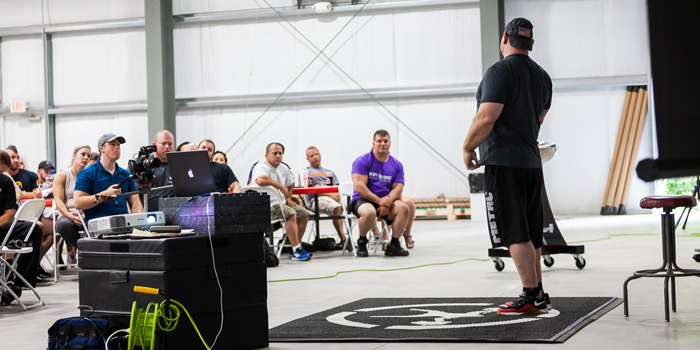
The elitefts Learn to Train X (LTTX) seminar took place in early August, bringing together trainers, coaches, athletes, and competitors across the powerlifting industry for the intensive three-day event. Participants were able to attend lectures from respected strength and performance educators, and also had the opportunity to experience hands-on instruction at training stations dedicated to perfecting the squat, bench press, and deadlift. To kick off the lecture series, Dave Tate spoke to the group about his approach to training.
WATCH: Learn to Train X — The Squat Checklist with Swede Burns
In this presentation, Tate explains the importance of the squat, bench press, and deadlift as key indicators in the sport of powerlifting. When architecting a training program, it’s important to keep in mind that every exercise should have some sort of dynamic correspondence to improving these “big three” lifts. Focusing on this concept of carry-over helps powerlifters train in a more intentional and strategic way, ultimately bolstering overall performance.
Key Indicator Mindset
Tate starts off by saying that everything has to have a reason. When it comes to powerlifting training, that means that every exercise has to have some sort of correspondence or carryover to the squat, bench press, or deadlift. Why? Because they are the key indicators of performance in the sport. Although hotly debated, this doesn’t necessarily mean that everyone has to train the actual lifts to be strong in the lifts – sometimes you do, and sometimes you don’t. Nonetheless, the majority of training programs should take a key indicator mindset, constantly tying back to these three accessory lifts.
Max Effort Movement
As an example, Tate begins to sketch out a sample training program to illustrate how dynamic correspondence carries through each component. He first discusses max effort movement for the squat, with the goal of waving that every week. However, beginners may need a week to get acclimated to the movement if they’ve never done a medium-stance safety bar squat before. In the second week, however, they should be able to work up until they have technical breakdown or they max out on it and not miss. The important thing to note is that the movements selected for max effort work must have some kind of dynamic correspondence to squat, bench press, or deadlift. This carryover can mean different things, but what it certainly does not mean is trying to fix a weakness with max effort work.
[The carryover] can be via time under tension or time under strain like we talked about, or it can be the movement itself. This is not a movement where you’re going to select an exercise to try to fix a weak point…The goal of the max effort exercise is not to bring up a weak point…Straining is the most important thing.
The more advanced a lifter is, the more movement they can use. This is because they are not going to rely on those movements to be indicators of where the strength is. Intermediate powerlifters, however, should use fewer movements in order to be able to better gauge how they are progressing. As they learn the movements and become increasingly coordinated, they are naturally going to break personal records. And yet, that doesn’t mean that they should stick with a particular movement for a 3-5-week cycle – hit it and get off of it, as Tate advises.
Fortunately, powerlifters don’t need to have a multitude of specialty bars to do this type of max effort work (although it can help). Tate notes that the movement can be any variation – a high-bar squat, front squat, back squat, or some type of pull. However, pulls should generally not be executed more than once a month for max effort work due to recovery time. The bottom line is that straining is the goal – straining in the safest possible environment.
Supplemental Exercise
Following the max effort work, Tate recommends supplemental exercise trained in a strength range of 3-5 reps. Powerlifters can reference Prilepin’s Chart to determine where exactly they should go when it comes to these exercises. Interestingly, Tate explains, the goal with the supplemental exercises is not to directly correspond to the squat, bench, and deadlift. Rather, it’s to correspond to the max effort exercise that in turn corresponds to the squat, bench, and deadlift. Simply put, it’s about making the thing that makes those three lifts better, better.
For those in doubt of what exactly this supplemental exercise might be, Tate acknowledges that in many cases, it’s hamstring work. Exercises such as glute ham raises that work the hamstring from origin and insertion are beneficial. In general, exercises where the knees and hips are moving at the same time tend to correspond more closely with the squat and deadlift. If a powerlifter is particularly conditioned and in-shape, they can potentially do an additional supplemental movement as part of their training program as well.
Accessory and Prehab Work
Just as the supplemental exercise served to make the max effort movement better, so the accessory work serves to make the supplemental exercise better. This is where movements like single-leg squats, sled drags, band pull-aparts, shoulder work, and ab work come into play. Tate notes that in particular, any time powerlifters can work the abs as a unit that’s pulling the hip-flexors and contracting the abs, the better – especially in comparison to ground-based ab work. Examples of this could be exercises such as pull-down abs or hanging leg raises.
As he comes to the end of his sample training program, Tate makes a point to clearly illustrate how each training component fuels performance of another training component. This waterfall-effect of dynamic correspondence ultimately feeds into the key indicators that really matter to Tate, and to any serious powerlifter: squat, bench press, and deadlift.









